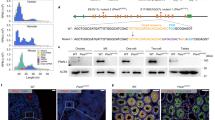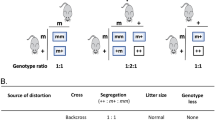Abstract
NLRP proteins are important components of inflammasomes with a major role in innate immunity. A subset of NLRP genes, with unknown functions, are expressed in oocytes and early embryos. Mutations of Nlrp5 in mice are associated with maternal-effect embryonic lethality and mutations of NLRP7 in women are associated with conception of biparental complete hydatidiform moles (biCHMs), suggesting perturbed processes of genomic imprinting. Recessive mutations on NLRP2/7 in humans are associated with reproductive disorders and appear to be induced by a demethylation of the maternal pronucleus. In this study, we find that radiation of NLRP genes occurred before the common ancestor of Afrotheria and Boreoeutheria, with the clade of oocyte-expressed genes originating before the divergence of marsupial and eutherian mammals. There have been multiple independent duplications of NLRP2 genes one of which produced the NLRP7 gene associated with biCHMs.



Similar content being viewed by others
References
Alders M, Ryan A, Hodges M, Bliek J, Feinberg AP, Privitera O, Westerveld A, Little PFR, Mannens M (2000) Disruption of a novel imprinted zinc-finger gene, ZNF215, in Beckwith–Wiedemann syndrome. Am J Hum Genet 66:1473–1484
Altschul SF, Madden TL, Schäffer AA, Zhang J, Zhang Z, Miller W, Lipman DJ (1997) Gapped BLAST and PSI-BLAST: a new generation of protein database search programs. Nucleic Acids Res 25:3389–3402
Benson D, Karsch-Mizrachi I, Lipman D, Ostell J, Wheeler D (2011) Genbank. Nucleic Acids Res 39:32–37
Burleigh JG, Hilu K, Soltis D (2009) Inferring phylogenies with incomplete data sets: a 5-gene, 567-taxon analysis of angiosperms. BMC Evol Biol 9:61
Darriba D, Taboada GL, Doallo R, Posada D (2011) ProtTest 3: fast selection of best-fit models of protein evolution. Bioinformatics 27:1164–1165
El-Maarri O, Seoud M, Coullin P, Herbiniaux U, Oldenburg J, Rouleau G, Slim R (2003) Maternal alleles acquiring paternal methylation in biparental complete hydatidiform moles. Hum Mol Genet 12:1405–1413
Fernandes R, Tsuda C, Perumalsamy AL, Naranian T, Chong J, Acton BM, Tong ZB, Nelson LM, Jurisicova A (2012) NLRP5 mediates mitochondrial function in mouse oocytes and embryos. Biol Reprod 86:138
Haig D (2005) The complex history of distal human chromosome 1q. Genomics 86:767–770
Hamatami T, Falco G, Carter MG, Akutsu H, Stagg CA, Sharov AA, Dudekula DB, VanBuren V, Ko MSH (2004) Age-associated alteration of gene expression patterns in mouse oocytes. Hum Mol Genet 13:2263–2278
Hartmann S, Vision T (2008) Using ests for phylogenomics: can one accurately infer a phylogenetic tree from a gappy alignment? BMC Evol Biol 8:95
Huelsenbeck JP, Ronquist F (2001) Mrbayes: Bayesian inference of phylogeny. Bioinformatics 17:754–755
Hughes AL (2006) Evolutionary relationships of vertebrate nacht domain-containing proteins. Immunogenetics 58:785–791
Inoue A, Zhang Y (2011) Replication-dependent loss of 5-hydroxymethylcytosine in mouse preimplantation embryos. Science 334:194
Iqbal K, Jin SG, Pfeifer GP, Szabó PE (2011) Reprogramming of the paternal genome upon fertilization involves genome-wide oxidation of 5-methylcytosine. Proc Natl Acad Sci USA 108:3642–3647
Jones DT, Taylor WR, Thornton JM (1992) The rapid generation of mutation data matrices from protein sequences. Comp Appl Biosci 8:275–282
Judson H, Hayward B, Sheridan E, Bonthron D (2002) A global disorder of imprinting in the human female germ line. Nature 416:539–42
Kersse K, Versputen J, Vanden Berghe T, Vandenabeele P (2011) The death-fold superfamily of homotypic interaction motifs. Trends Biochem Sci 36:541–552
Kim B, Kan R, Anguish L, Nelson LM, Coonrod SA (2010) Potential role for mater in cytoplasmic lattice formation in murine oocytes. PLoS ONE 5:e12587
Kou YC, Shao L, Peng HH, Rosetta R, del Gaudio D, Wagner AF, Al-Hussaini TK, van der Veyver IB (2008) A recurrent intragenic genomic duplication, other novel mutations in NLRP7 and imprinting defects in recurrent biparental hydatidiform moles. Mol Hum Reprod 14:33–40
Kück P, Meusemann K, Dambach J, Thormann B, von Reumont BM, Wägele JW, Misof B (2010) Parametric and non-parametric masking of randomness in sequence alignments can be improved and leads to better resolved trees. Frontiers Zool 7:10
Kufer TA, Sansonetti PJ (2011) NLR functions beyond pathogen recognition. Nat Immunol 12:121–128
Laing KJ, Purcell MK, Winton JR, Hansen JD (2008) A genomic view of nod-like receptor family in teleost fish: identification of a novel NLR subfamly in zebrafish. BMC Evol Biol 8:42
Meyer E, Lim D, Pasha S, Tee LJ, Rahman F, Yates JR, Woods CG, Reik W, Maher ER (2009) Germline mutation in NLRP2 (NALP2) in a familial imprinting disorder (Beckwith–Wiedemann syndrome). PLoS Genet 85:e1000423
Murdoch S, Djuric U, Mazhar B, Seoud M, Khan R, Kuick R, Bagga R, Kircheisen R, Ao A, Ratti B, Hanash S, Rouleau GA, Slim R (2006) Mutations in NALP7 cause recurrent hydatidiform moles and reproductive wastage in humans. Nat Genet 38:300–301
Ng ACY, Eisenberg JM, Heath RJW, Huett A, Robinson CM, Nau GJ, Xavier RJ (2011) Human leucine-rich repeat proteins: a genome-wide bioinformatic categorization and functional analysis in innate immunity. Proc Natl Acad Sci USA 108:4631–4638
Notredame C, Heringa J, Higgins DG (2000) T-coffee: a novel method for fast and accurate multiple sequence alignment. J Mol Biol 302:205–217
Ohsugi M, Zheng P, Baibakov B, Li L, Dean J (2008) Maternally-derived filia–mater complex localizes asymmetrically in cleavage-stage mouse embryos. Development 135:259–269
Okonechnikov K, Golosova O, Fursov M, The UGENE Team (2012) Unipro ugene: a unified bioinformatics toolkit. Bioinformatics 28:1166–1167
Parry DA, Logan CV, Hayward BE, Shires M, Landolsi H, Diggle C, Carr I, Rittore C, Touitou I, Philibert L, Fisher RA, Fallahian M, Huntriss JD, Picton HM, Malik S, Taylor GR, Johnson CA, Bonthron DT, Sheridan EG (2011) Mutations causing familial biparental hydatidiform mole implicate c6orf221 as a possible regulator of genomic imprinting in the human oocyte. Am J Hum Genet 89:451–458
Peng H, Chang B, Lu C, Su J, Wu Y, Lv P, Wang Y, Jun L, Zhang B, Quan F, Guo Z, Zhang Y (2012) NLRP2, a maternal effect gene required for early embryonic development in the mouse. PLoS ONE 7:e30344
Pierre A, Gautier M, Callebaut I, Bontoux M, Jeanpierre E, Pontarotti P, Monget P (2007) Atypical structure and phylogenomic evolution of the new eutherian oocyte- and embryo-expressed KHDC1/DPPA5/ECAT1/OOEP gene family. Genomics 90:583–594
Ponsuksili S, Brunner RM, Goldammer T, Kühn C, Walz C, Chomdej S, Tesfaye D, Schellander K, Wimmers K, Schwerin M (2006) Bovine NALP5, NALP8, and NALP9 genes: assignment to a QTL region and the expression in adult tissues, oocytes, and preimplantation embryos. Biol Reprod 74:577–584
Reik W, Walter J (2001) Evolution of imprinting mechanisms: the battle of the sexes begins in the zygote. Nat Genet 27:255–256
Ronquist F, Huelsenbeck JP (2003) Mrbayes 3: Bayesian phylogenetic inference under mixed models. Bioinformatics 19:1572–1574
Schulz R, Proudhon C, Bestor TH, Woodfine K, Lin CS, Lin SP, Prissette M, Oakey RJ, Bourc’his D (2010) The parental non-equivalence of imprinting control regions during mammalian development and evolution. PLoS Genet 6:e1001214
Strowig T, Henao-Mejia J, Elinav E, Flavell R (2012) Inflammasomes in health and disease. Nature 481:278–286
Sukumaran J, Holder M (2010) Dendropy: a python library for phylogenetic computing. Bioinformatics 26:1569–1571
Tian X, Pascal G, Monget P (2009) Evolution and functional divergence of NLRP genes in mammalian reproductive systems. BMC Evol Biol 9:202
Tong ZB, Gold L, Pfeifer KE, Dorward H, Lee E, Bondy CA, Dean J, Nelson LM (2000) Mater, a maternal effect gene required for early embryonic development in mice. Nat Genet 26:267–268
Wiens JJ (2003) Missing data, incomplete taxa, and phylogenetic accuracy. Syst Biol 52:528–538
Wiens JJ, Moen DS (2008) Missing data and the accuracy of Bayesian phylogenetics. J Syst Evol 46:307–314
Wiens JJ, Morrill MC (2011) Missing data in phylogenetic analysis: reconciling results from simulations and empirical data. Syst Biol 60:719–731
Wossidlo M, Nakamura T, Lepikhov K, Marques CJ, Zakhartchenko V, Boiani M, Arand J, Nakano T, Reik W, Walter J (2011) 5-Hydroxymethylcytosine in the mammalian zygote is linked with epigenetic reprogramming. Nat Commun 2:241
Zhang P, Dixon M, Zucchelli M, Hambiliki F, Levkov L, Hovatta O, Kere J (2008) Expression analysis of the NLRP gene family suggests a role in human preimplantation development. PLoS ONE 3:e2755
Zheng P, Dean J (2009) Role of filia, a maternal effect gene, in maintaining euploidy during cleavage-stage mouse embryogenesis. Proc Natl Acad Sci USA 106:7473–7478
Zwickl DJ (2006) Genetic algorithm approaches for the phylogenetic analysis of large biological sequence datasets under the maximum likelihood criterion. PhD Dissertation, The University of Texas at Austin, Austin
Author information
Authors and Affiliations
Corresponding author
Additional information
Supported by an Innovative Collaboration Award by the Howard Hughes Medical Institute to Catherine Dulac.
Electronic supplementary material
Below is the link to the electronic supplementary material.
239_2014_9614_MOESM1_ESM.pdf
Consensus phylogenetic tree of the NLRP gene family using Bayesian and maximumlikelihood methods. The support for the two methods is given as a pair of numbers between 0 (no support)and 1 (full support) for the Bayesian and maximum likelihood methods, respectively. These two valuesare separated by a vertical line character. A consensus cut-off threshold of 0:75 was used. Supportbelow the threshold is shown as an asterisk. (PDF 27 KB)
239_2014_9614_MOESM2_ESM.pdf
Table of all the sequences used in the analyses. The table contains the gene name,species of origin, chromosome location, NCBI accession number, and nucleotide position in the chromosome. (PDF 58 KB)
239_2014_9614_MOESM3_ESM.eps
Graphical depiction of NLRP genes and their flanking markers in all mammalianspecies used in this study. Genes are depicted as squares, chromosomes as vertical lines, and gene duplicationsand moves are depicted by arches. Genes are colored according to three categories. Non-NLRPgenes are gray, orthologs of human NLRP genes are cyan and gene duplications are colored yellow. (PS 144 KB)
239_2014_9614_MOESM5_ESM.eps
Consensus phylogenetic tree of the NLRP gene family excluding reconstructed pseudogenes.The phylogenetic tree was inferred using MrBayes for 5,000,000 time steps, using the sameparameters as in Fig. 1. (PS 353 KB)
Rights and permissions
About this article
Cite this article
Duéñez-Guzmán, E.A., Haig, D. The Evolution of Reproduction-Related NLRP Genes. J Mol Evol 78, 194–201 (2014). https://doi.org/10.1007/s00239-014-9614-3
Received:
Accepted:
Published:
Issue Date:
DOI: https://doi.org/10.1007/s00239-014-9614-3




